

|
| BELGIË / BELGIQUE / BELGIEN | BELGIUM |
| gewest/région/Region: Vlaanderen / Flandre / Flandern | region: Flanders |
| provincie/province/Provinz: Oost-Vlaanderen / Flandre-Orientale / Ostflandern | province: East Flanders |
fr: Gand
| de, nl: Gent
| |
b>Ghent (Flemish: Gent, French: Gand) is the capital and the largest city of the Belgian province of East Flanders and, after Antwerp, the second largest municipality in Belgium. The municipality comprises the city of Ghent and the surrounding towns of Afsnee, Desteldonk, Drongen, Gentbrugge, Ledeberg, Mariakerke, Mendonk, Oostakker, Sint-Amandsberg, Sint-Denijs-Westrem, Sint-Kruis-Winkel, Wondelgem and Zwijnaarde. The municipality has a population of about 257,000 (2015), while the entire metropolitan area has a population of about 594,600 (2008).
Archaeological evidence shows human presence in the region of the confluence of Scheldt and Leie going back as far as the Stone Age and the Iron Age. Most historians believe that the older name for Ghent, Ganda, is derived from the Celtic word 'ganda' which means confluence. During the Middle Ages, Ghent grew from three nuclei, the two abbeys of St. Peter and St. Bavo (both founded around 650) and a commercial centre. Within the protection of the County of Flanders, the city flourished from the 11th century, growing to become a small city-state. By the 13th century, Ghent was the biggest city in Europe north of the Alps after Paris. The wool industry, originally established at Brugge, created the first European industrialized zone in Ghent in the High Middle Ages. Trade with England (but not Scotland) suffered significantly during the Hundred Years' War 1337–1453). The city recovered in the 15th century, when Flanders was united with neighbouring provinces under the Dukes of Burgundy. Around this time the centre of political and social importance in the Low Countries started to shift from Flanders (Brugge and Ghent) to Brabant (Antwerp and Brussels), although Ghent continued to play an important role. With Brugge, the city led two revolts against Maximilian of Austria (Emperor Maximilian I), the first monarch of the House of Habsburg to rule Flanders. In 1500, Juana of Castile gave birth to Charles V, who became Holy Roman Emperor and King of Spain. The late 16th and the 17th centuries brought devastation because of the Eighty Years' War (1568–1648), which ended the role of Ghent as a centre of international importance. In 1745, the city was captured by French forces during the War of the Austrian Succession before being returned to the Empire of Austria of the House of Habsburg following the Treaty of Aix-la-Chapelle (Aachen) in 1748, when this part of Flanders became known as the Austrian Netherlands until 1815. The Treaty of Ghent, negotiated here and adopted on Christmas Eve 1814, formally ended the War of 1812 (the North American phase of the Napoleonic Wars between Great Britain and the United States). After the Battle of Waterloo and the Congress of Vienna (1815), Ghent and Flanders became a part of the United Kingdom of the Netherlands until 1830 when the Belgian Revolution led to the establishment of an independent Belgium. Ghent was occupied by German forces in both World Wars but luckily escaped severe destruction.
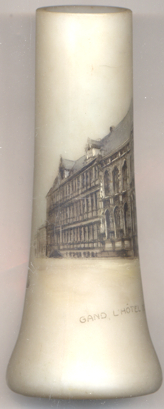
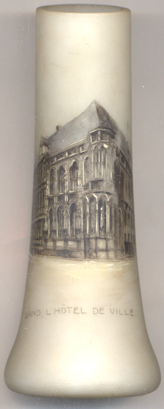
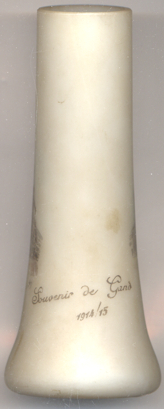

Construction of the historic  town hall [left, no. 3188], known locally
as Stadhuis, began in the late 15th century, but it was stopped and then resumed again several times before finally being
completed in the 18th century. The right wing was built in 1482–1539 in flamboyant late Gothic style
by Rombout Keldermans and Domenik de Waghemakere. The left wing in Renaissance style was constructed in 1635.
Further additions followed in the 18th century.
Glass no. 3188 is inscribed and dated on the back: Souvenir de Gand 1914/15.
town hall [left, no. 3188], known locally
as Stadhuis, began in the late 15th century, but it was stopped and then resumed again several times before finally being
completed in the 18th century. The right wing was built in 1482–1539 in flamboyant late Gothic style
by Rombout Keldermans and Domenik de Waghemakere. The left wing in Renaissance style was constructed in 1635.
Further additions followed in the 18th century.
Glass no. 3188 is inscribed and dated on the back: Souvenir de Gand 1914/15.
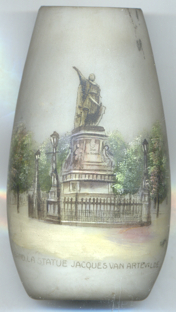
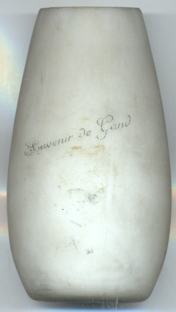
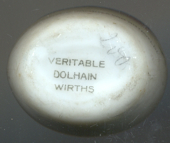
The  monument
monument
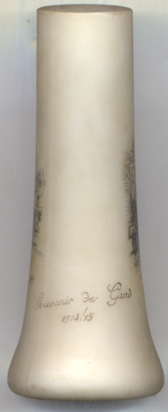
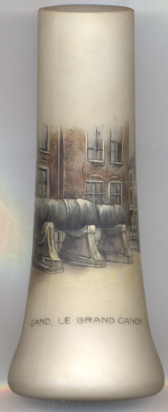
The  Grand Cannon [right, no. 3095],
popularly named Dulle Griet in Flemish or Marguerite l'Enragée in French, weighs 12,500 kg.
The wrought-iron bombard was constructed in the first half of the 15th century from 32 longitudinal bars enclosed by
61 rings. In 1452, the bombard was employed by the city of Ghent in the siege of Oudenaarde, but fell into the hands
of the defenders on the retreat and was only returned to Ghent in 1578. Today, the bombard is set up close to the
Friday Market square in the old town.
Glass no. 3095 is inscribed and dated on the back: Souvenir de Gand 1914/15.
Grand Cannon [right, no. 3095],
popularly named Dulle Griet in Flemish or Marguerite l'Enragée in French, weighs 12,500 kg.
The wrought-iron bombard was constructed in the first half of the 15th century from 32 longitudinal bars enclosed by
61 rings. In 1452, the bombard was employed by the city of Ghent in the siege of Oudenaarde, but fell into the hands
of the defenders on the retreat and was only returned to Ghent in 1578. Today, the bombard is set up close to the
Friday Market square in the old town.
Glass no. 3095 is inscribed and dated on the back: Souvenir de Gand 1914/15.
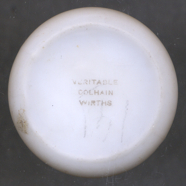
All glasses (no. 3091, no. 3095 and no. 3188) are marked on the bottom:
VERITABLE DOLHAIN WIRTHS.
[https://en.wikipedia.org/wiki/Ghent, https://de.wikipedia.org/wiki/Ghent;
http://www.bargaintraveleurope.com/11/Belgium_Friday_Market_Square_Artevelde_Ghent.htm, https://en.wikipedia.org/wiki/Jacob_van_Artevelde,
https://nl.wikipedia.org/wiki/Pieter_De_Vigne;
https://en.wikipedia.org/wiki/Dulle_Griet;
https://www.expedia.com/Ghent-Town-Hall-Ghent.d6098920.Vacation-Attraction]
![[scale]](lineal.jpg)